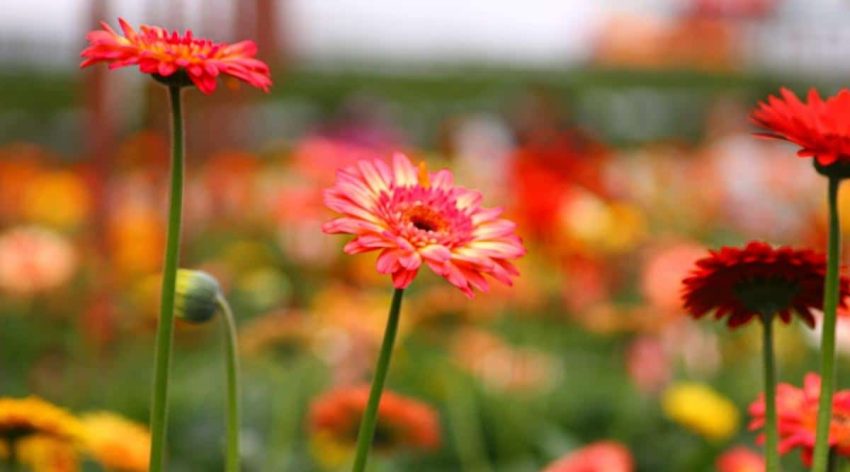metlifedentalnow.net – Gerbera daisies (Gerbera jamesonii) are one of the most popular and beloved flowers worldwide. Known for their vibrant, colorful blooms and striking appearance, Gerbera daisies are a favorite among gardeners, florists, and flower enthusiasts alike. These cheerful flowers are available in an array of bright colors, including yellow, orange, pink, red, and white, making them perfect for adding a pop of color to any garden, bouquet, or floral arrangement. Here’s a closer look at the captivating Gerbera Daisy and how to care for it in your garden.
Appearance and Characteristics
Gerbera daisies are known for their bold, large blooms, which can grow up to 4 inches in diameter. The flowers come in a wide range of vibrant colors, including yellow, orange, pink, red, and white. The petals are usually long and narrow, radiating outward from a central disk, giving the flower a daisy-like appearance. The bright, eye-catching blooms are often complemented by their dark, contrasting centers, which can be black, brown, or even green, depending on the variety.
The plant itself is a low-growing perennial or annual, depending on the climate. In cooler regions, Gerbera daisies are often grown as annuals, while in warmer climates, they can be grown as perennials, blooming year after year. The foliage consists of dark green, jagged-edged leaves that form a rosette at the base of the plant, serving as an attractive backdrop to the flowers.
Planting and Growing Conditions
Gerbera daisies thrive in full sun, requiring at least 6 hours of sunlight per day to produce their large, colorful blooms. They prefer well-drained, slightly acidic soil that is rich in organic matter. Gerbera daisies are best planted in areas where the soil drains well, as they do not like to sit in soggy conditions.
For gardeners in colder climates, Gerbera daisies are usually started indoors in early spring from seeds or transplants. Once the danger of frost has passed, the plants can be moved outdoors. In warmer climates, Gerbera daisies can be directly sowed in the garden or grown as perennials.
It’s important to space the plants about 12 to 18 inches apart to give them room to grow and ensure proper air circulation, which helps prevent fungal diseases.
Care and Maintenance
Gerbera daisies are relatively easy to care for but do require some attention to thrive and produce their beautiful blooms. Water the plants consistently, ensuring the soil remains evenly moist. However, avoid over-watering, as Gerbera daisies are susceptible to root rot if the soil becomes waterlogged. To prevent this, ensure the plant is in a location with well-draining soil.
Fertilizing Gerbera daisies is essential for healthy growth and vibrant blooms. Use a balanced, water-soluble fertilizer, applying it every 4 to 6 weeks during the growing season. Regular deadheading, or removing spent blooms, will encourage the plant to produce more flowers throughout the season.
Gerbera daisies can benefit from occasional pruning, especially when the foliage becomes overgrown or damaged. Trim back any dead or yellowing leaves to keep the plant looking tidy and to promote new growth.
Pests and Problems
While Gerbera daisies are relatively resilient, they can occasionally face pest problems, including aphids, spider mites, and whiteflies. These pests can be controlled using insecticidal soap or by introducing beneficial insects like ladybugs, which feed on aphids.
Additionally, Gerbera daisies are susceptible to fungal diseases like powdery mildew and botrytis blight, especially if they are grown in humid conditions or if there is poor air circulation around the plant. To reduce the risk of disease, avoid overhead watering and ensure that the plants are spaced far enough apart to allow for proper airflow.
Uses in Landscaping
Gerbera daisies are incredibly versatile and can be used in a wide range of landscaping applications. Their vibrant flowers make them ideal for adding color to flower beds, borders, or container gardens. They can be grown as part of a mixed perennial garden or as a stand-alone focal point in a sunny spot.
Because of their long-lasting blooms, Gerbera daisies are also a popular choice for cut flowers. The bright, cheerful blooms are commonly used in floral arrangements, including bouquets for weddings, birthdays, and other special occasions. Their striking colors and large size make them stand out in any floral design.
Conclusion
Gerbera daisies are among the most beloved and striking flowers in the gardening world. With their bold, vibrant colors and large, daisy-like blooms, they bring a cheerful and lively atmosphere to any garden or landscape. Whether planted in garden beds, containers, or used as cut flowers in arrangements, Gerbera daisies are sure to brighten any space. With a little care and attention, these colorful beauties will reward you with months of vibrant blooms and a burst of color that can’t be missed.

